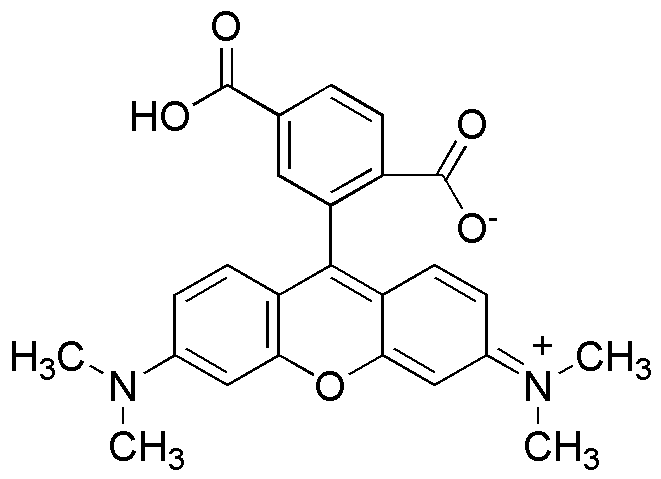6-Carboxy-tetramethylrhodamine is widely utilized in research focused on:
- Fluorescent Labeling: This compound is commonly used as a fluorescent dye in biological research, allowing scientists to label and visualize proteins, nucleic acids, and other biomolecules in live cells.
- Flow Cytometry: It serves as a vital tool in flow cytometry applications, enabling the analysis of cell populations based on their fluorescence characteristics, which is crucial for immunology and cancer research.
- Immunohistochemistry: Researchers employ it in immunohistochemical staining to detect specific antigens in tissue samples, aiding in the diagnosis of diseases and understanding tissue architecture.
- Environmental Monitoring: The compound can be used in environmental studies to track pollutants or biological markers in water samples, providing insights into ecosystem health.
- Drug Development: In pharmaceutical research, it assists in the development of targeted drug delivery systems, where its fluorescent properties help in monitoring drug release and distribution in biological systems.
Información general
Propiedades
Seguridad y normativas
Aplicaciones
6-Carboxy-tetramethylrhodamine is widely utilized in research focused on:
- Fluorescent Labeling: This compound is commonly used as a fluorescent dye in biological research, allowing scientists to label and visualize proteins, nucleic acids, and other biomolecules in live cells.
- Flow Cytometry: It serves as a vital tool in flow cytometry applications, enabling the analysis of cell populations based on their fluorescence characteristics, which is crucial for immunology and cancer research.
- Immunohistochemistry: Researchers employ it in immunohistochemical staining to detect specific antigens in tissue samples, aiding in the diagnosis of diseases and understanding tissue architecture.
- Environmental Monitoring: The compound can be used in environmental studies to track pollutants or biological markers in water samples, providing insights into ecosystem health.
- Drug Development: In pharmaceutical research, it assists in the development of targeted drug delivery systems, where its fluorescent properties help in monitoring drug release and distribution in biological systems.
Documentos
Hojas de datos de seguridad (HDS)
La SDS proporciona información de seguridad completa sobre la manipulación, el almacenamiento y la eliminación del producto.
Especificación del producto (PS)
La PS proporciona un desglose completo de las propiedades del producto, incluida la composición química, el estado físico, la pureza y los requisitos de almacenamiento. También detalla los rangos de calidad aceptables y las aplicaciones previstas del producto.
Certificados de análisis (COA)
Busque certificados de análisis (COA) ingresando el número de lote del producto. Los números de lote y de partida se pueden encontrar en la etiqueta de un producto después de las palabras "Lote" o "Lote".
Número de catálogo
Número de lote/lote
Certificados de origen (COO)
Este certificado de origen confirma el país en el que se fabricó el producto y también detalla los materiales y componentes utilizados en él y si se deriva de fuentes naturales, sintéticas u otras fuentes específicas. Este certificado puede ser necesario para cumplir con las normativas aduaneras, comerciales y regulatorias.
Número de catálogo
Número de lote/lote
Hojas de datos de seguridad (HDS)
La SDS proporciona información de seguridad completa sobre la manipulación, el almacenamiento y la eliminación del producto.
DownloadEspecificación del producto (PS)
La PS proporciona un desglose completo de las propiedades del producto, incluida la composición química, el estado físico, la pureza y los requisitos de almacenamiento. También detalla los rangos de calidad aceptables y las aplicaciones previstas del producto.
DownloadCertificados de análisis (COA)
Busque certificados de análisis (COA) ingresando el número de lote del producto. Los números de lote y de partida se pueden encontrar en la etiqueta de un producto después de las palabras "Lote" o "Lote".
Número de catálogo
Número de lote/lote
Certificados de origen (COO)
Este certificado de origen confirma el país en el que se fabricó el producto y también detalla los materiales y componentes utilizados en él y si se deriva de fuentes naturales, sintéticas u otras fuentes específicas. Este certificado puede ser necesario para cumplir con las normativas aduaneras, comerciales y regulatorias.


